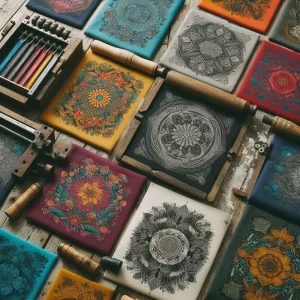Screen Printing for Fabric: Textile Designs
In the domain of textile design, screen printing on fabric stands as an intriguing artistic avenue. As ink is forced through a mesh screen onto various fabric surfaces, it’s not just the vibrant colors and patterns that come to life, but the artist’s imagination too. From cotton and silk to blended fabrics, the technique’s versatility opens up a plethora of design possibilities. So, if you’re an artist seeking a unique medium for expression or someone intrigued by textile design, why not explore the fascinating world of screen printing?
Understanding Screen Printing Basics
Let’s explore the basics of screen printing, a versatile technique that allows you to create vibrant fabric screen printing designs on a variety of fabrics, from cotton and silk to wool and synthetic blends. Screen printing on fabric involves the application of ink through a mesh screen onto a fabric surface. It’s a popular method for textile screen printing due to its ability to produce clear, high-quality images with a single application of ink.
One key aspect is understanding the types of fabric suitable for screen printing. Cotton and cotton blends, for instance, are favoured as they absorb ink more readily than synthetics. Silk, with its softness and high lustre, presents unique challenges, such as preventing fabric movement during printing. Wool, less absorbent, may be best left to experienced printers, especially for pure wool. Synthetic fibers like nylon, acrylics, and polyester are less porous than natural fibers, presenting challenges for ink adhesion. Jersey fabrics, often used for T-shirts, give superior results when printed with water-based textile inks.
Tools Required for Screen Printing
Having understood the types of fabrics suitable for screen printing, it’s equally important to know the tools required to effectively carry out the process. Essential tools for screen printing range from the screen, squeegee, and inks to more specific items like emulsion and exposure units.
The screen, usually made of fine mesh stretched over a frame, is the bedrock of the printing process. The squeegee, a rubber blade attached to a wooden or metal handle, is used to push the ink through the screen onto the fabric. Inks, available in a variety of types and colors, are chosen based on the fabric type and the desired effect.
The emulsion, a light-sensitive chemical solution, is spread on the screen and, when exposed to light, hardens to create a stencil of the design. The exposure unit, a box with a light source, is used to harden the emulsion. Other tools include a darkroom for preparing the screen, a washout booth for cleaning, and a heat press or drying rack for curing the print. These tools, while varying in complexity and cost, all contribute to the art of screen printing.
Step-by-Step Screen Printing Process
Before delving into the screen printing process, it is crucial to have your tools and workspace ready. The first step involves preparing your artwork. This can be done using either stencils or photographic techniques. Each color in the design needs a separate stencil and screen.
 Once the artwork is ready, the next step is screen preparation. This entails cleaning the screen with a high-pressure hose and applying a coat of photographic emulsion for precise prints. The screen is then exposed to a light source for image transfer.
Once the artwork is ready, the next step is screen preparation. This entails cleaning the screen with a high-pressure hose and applying a coat of photographic emulsion for precise prints. The screen is then exposed to a light source for image transfer.
The actual printing process begins by laying out the fabric and securing it to prevent movement. Stops are measured for repeat designs on the print rail. Then, the printing medium is applied at the bottom of the screen. Using a squeegee, the medium is passed across the screen. When the screen is lifted, the design is revealed. It’s worth mentioning that different printing mediums can be used to achieve various effects.
Screen printing is a process that requires patience and precision, but the results can be incredibly satisfying and unique. It allows artists to create beautiful, custom designs on a variety of fabric types.
Troubleshooting Common Screen Printing Issues
While mastering the screen printing process can lead to stunning results, it’s equally important to know how to troubleshoot common issues that may arise. One common problem is ink bleeding, which often occurs when the ink isn’t properly dried or cured. The solution is to make sure the right temperature and duration for curing, based on the ink and fabric type.
Another issue is image distortion. This happens when the screen isn’t properly tensioned or the squeegee pressure is uneven. To fix this, it’s essential to maintain the correct screen tension and apply even squeegee pressure.
Misregistration, where the colors don’t align properly, is another common hiccup. This can be resolved by accurately aligning the screens before printing.
Inadequate ink coverage is another issue, often due to insufficient ink or incorrect squeegee angle. The remedy is to ensure sufficient ink application and correct squeegee technique.
Lastly, screen blockage, usually caused by dried ink or improper cleaning, can be avoided by keeping the screens clean and the ink at the right consistency.
In essence, troubleshooting requires understanding the root cause of the issue and applying the suitable solution. It’s all part of mastering the art of screen printing.
Exploring Innovative Textile Design Ideas
When it comes to screen printing for fabric, innovative textile design ideas can breathe fresh life into any project. Artists are consistently pushing boundaries, finding new ways to create unique and eye-catching designs. In this section, we will explore some of these innovative concepts, and how they’re shaking up the world of textile design.
Screen Printing Art
Screen printing art, an innovative form of textile design, allows artists to transform ordinary fabrics into unique masterpieces. This technique provides a creative outlet for artists to express their individuality and artistic vision. Whether it’s a bold graphic on cotton or a delicate pattern on silk, the possibilities are endless.
Screen printing on fabric involves creating a stencil, or a screen, and then using it to apply layers of ink on the printing surface. Each color is applied using a different stencil, one at a time, combined to achieve the final look. The process demands precision and creativity, offering a limitless spectrum of design possibilities.
The choice of fabric plays a critical role in the final outcome of the design. Cotton and cotton blends are popular due to their absorbent nature, while silk offers a luxurious finish. Meanwhile, synthetic fibers like polyester and acrylic present unique challenges in ink adhesion.
Screen printing art is not only about creating beautiful patterns but also about exploring different materials and techniques. This innovative form of textile design can be a rewarding endeavor for those with a keen eye for detail and a passion for creativity.
Frequently Asked Questions
What Are the Environmental Impacts of Screen Printing on Different Fabrics?
Screen printing’s environmental impact varies by fabric. Cotton’s high water usage raises concerns. Synthetics, like polyester, emit harmful chemicals during production. However, using organic cotton or recycled synthetics can reduce these effects, making it more eco-friendly.
How Can We Ensure Colorfastness in Screen Printed Fabrics?
To guarantee colorfastness in screen-printed fabrics, they’d heat set the ink after printing. This process helps the ink bond better with the fabric, making the colors more resistant to fading or washing out.
What Safety Measures Are Necessary During the Screen Printing Process?
They must wear protective gear including gloves and goggles. They’re also advised to work in well-ventilated areas to avoid ink fumes and to properly store flammable materials. Regular cleaning reduces the risks of ink or chemical spills.
What Are Some Emerging Trends in Textile Screen Printing?
In textile screen printing, they’re seeing a rise in sustainability, with the increased use of organic cotton. There’s also a trend towards intricate, multi-colored designs, reflecting advances in screen printing technology and techniques.






